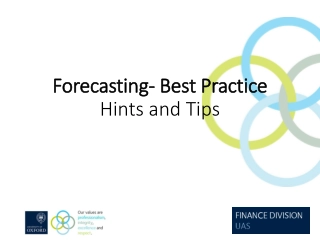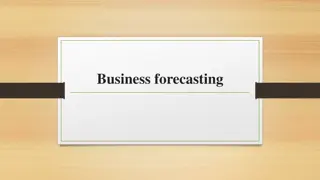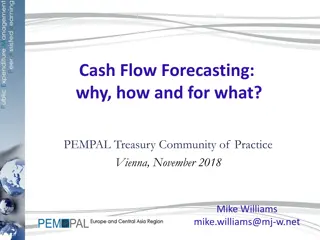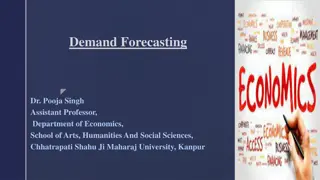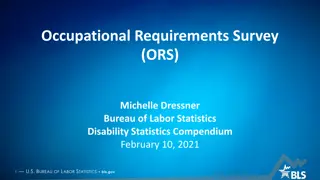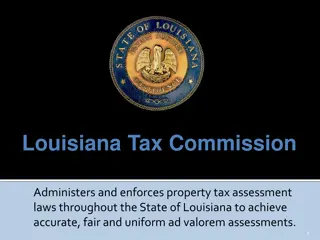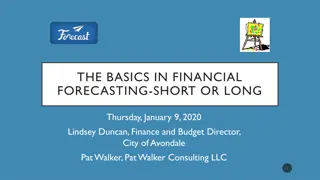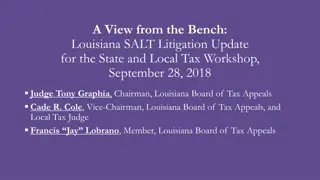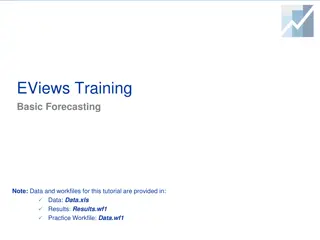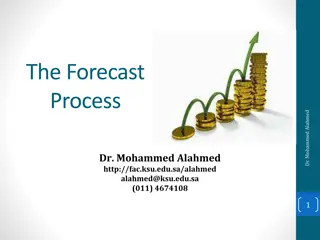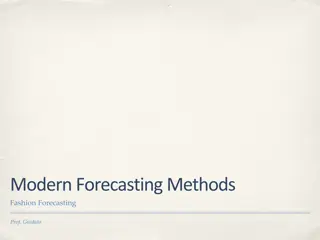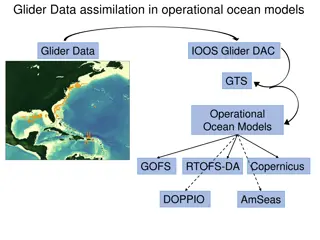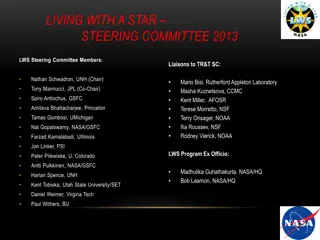Occupational Forecasting and Industry Projections in Louisiana
Occupational Forecasting and Industry Projections in Louisiana are crucial for workforce planning and economic development. The process involves annual projections by industry and occupation, updated with new demand and wage data. The Occupational Forecasting Conference, overseen by key stakeholders, ensures accurate forecasting through a two-step system. The methodology includes statistical modeling, economic trend analysis, and collaboration with various organizations. The focus is on providing short-term and long-term forecasts for 94 industries across 8 regions in the state.
Download Presentation

Please find below an Image/Link to download the presentation.
The content on the website is provided AS IS for your information and personal use only. It may not be sold, licensed, or shared on other websites without obtaining consent from the author. Download presentation by click this link. If you encounter any issues during the download, it is possible that the publisher has removed the file from their server.
E N D
Presentation Transcript
Click to edit Master text styles Second level Third level Fourth level Fifth level
Occupational Forecasting Occupational projections Developed annually by Occupational Forecasting Conference Approved by Workforce Investment Council Two-step process: Projections by Industry Projections by Occupation Star-Rating system Occupations updated annually based on new demand projections, wage data, and openings data 2
Occupational Forecasting Conference The governor or his designee. The executive director of the Louisiana Workforce Commission or his designee. One person appointed by the governor from a list of three nominees submitted by the Louisiana Association of Business and Industry. One member appointed by the governor from a list of three nominees submitted by the Louisiana AFL-CIO. One member appointed by the governor from a list of three non-public nominees submitted by the WIC. Two members, each of whom shall be a faculty member of a public or private university or college in Louisiana, who shall be econometricians and have occupational forecasting expertise or expertise in economic planning and industry/occupation matrix formulation, submitted by the Louisiana Board of Regents. The secretary of the Department of Economic Development or his designee. The president of the Louisiana Community and Technical College System or his designee. One member of the Louisiana Minority Supplier Development Council. 3
Industry Forecasts Methodology LWC produces baseline statistical model projections, using historical data and Bureau of Labor and Statistics (BLS) MicroMatrix software Louisiana one of a handful of states using wage records in addition to standard BLS surveys LWC contracts with LSU to review and refine projections: Analyze prevailing economic trends: develop & evaluate several alternative models Contact Louisiana driver firms, regional economic development organizations, Louisiana Health Works Commission, LCA, LMOGA, GBRIA/SWLA/GNO Business Roundtable, ABC, local WIBs, etc. Incorporate economic development initiatives and major announcements Review Coastal Restoration Master Plan and annual updates 94 distinct industries in each Regional Labor Market Area statewide + 8 regions = 846 total 2 forecasts per industry-region: short-term (2015) & long-term (2022) 4
Occupational Projections and Star-Ratings Occupational Projections: Process begins upon receiving formal approval of industry projections by OFC Evaluate staffing patterns and replacement rates by industry, updating where necessary with Louisiana-specific data Utilize staffing patterns and replacement rates to convert industry projections to occupation projections Replacement rates are provided by BLS and updated based on population demographics from Census data and input from driver firms Review occupational forecasts in all regions (3,710 total) Star-Rating System: Rank occupations based on wages, openings, and short-term/ long-term demand and percentage growth Convert average component ranking to stars 4 and 5 Star Jobs have the best outlook and pay 5
Short-term vs. Long-term 2015 2022 Improved accuracy Individual project timelines included in analysis Less variance from year to year Major swings are smoothed out 6
Demand by occupation Listed by Standard Occupational Classification (SOC) Code Annual demand = Growth + Replacement Official forecasts project employment levels and openings using the best data available today. For the WISE Council, adjustments were made to the forecasts by LED and LWC to reflect recruitment/expansion projects in the pipeline. 7
Gap Analysis Gap Annual Job Openings Annual Completions (or Surplus) 8
Supply by academic completer Post-secondary completer data by Classification of Instructional Programs (CIP codes) Board of Regents data used to account for all public completers Technical Competency Areas (TCAs) data provided by LCTCS Integrated Postsecondary Education Data System (IPEDS) data used to account for private completers Must consider private schools outputs to accurately identify gaps 9
Matching degrees to jobs (CIP to SOC) The NCES/BLS Crosswalk identifies postsecondary programs that prepare individuals directly for specific occupations. For example: Program (CIP Title) Occupations (SOCs) Financial Managers Chief Executives General and Operations Managers Budget Analysts Credit Analysts Finance, General Financial Analysts Personal Financial Advisors Loan Officers Financial Specialists, All Other Business Teachers, Postsecondary This crosswalk indicates that completers in Finance, General are prepared for employment in these occupations that traditionally require some form of postsecondary training. 10
Matching jobs to degrees (SOC to CIP) The crosswalk also works in the other direction, illustrating that multiple academic programs can prepare individuals for the same occupation. Occupation (SOC) Program (CIP Title) Accounting and Finance Accounting and Business Management Financial Analyst Finance, General 11
New completers needed for all gap 4 & 5 star jobs are aggregated at the program level New Completers Needed (Program Gap) Program (CIP Title) Accounting and Finance Accounting and Business Management Finance, General 1 20 708 12
The Statewide Workforce Demand and Gap Analysis is conducted as follows: 1. Matching Completers to Occupations: Using the NCES/BLS CIP to SOC Crosswalk, Louisiana postsecondary programs are matched to occupations. Adaptations were made to account for conditions specific to Louisiana. 2. Crosswalking Completers: Using 2012 postsecondary completer data (the most current year available), completers are distributed to their crosswalked occupations based on the proportion of total annual openings for all of the program s crosswalked occupations. 3. Identify Targeted Programs: All crosswalked completers are then aggregated at the occupational level, and those 4 & 5 Star Jobs with a gap (i.e., more total annual openings than aggregated crosswalked completers) are identified. 4. Filling the Gap: The gap for identified 4 & 5 Star Jobs is then assigned to crosswalked programs based on the proportion of completers in programs that crosswalk to that job. The results are then aggregated at a program level to indicate the number of new completers needed in high demand programs to help close the gap for identified 4 & 5 Star Jobs. 13
Gap Analysis Gap Annual Job Openings Annual Completions (or Surplus) 14



